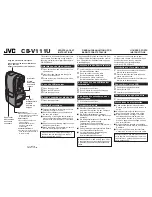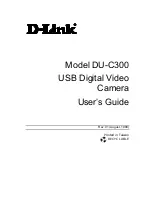
53
ª
Cautions for Storage
Before storing the Movie Camera, take the
Cassette out and detach the Battery.
Store all the components in a dry place with a
relatively stable temperature.
(Recommended Temperature: 15 to 25
o
C,
Recommended Humidity: 40 to 60%)
Movie Camera
≥
Wrap it with a soft cloth to prevent dust from
getting into the Camera.
≥
Do not leave the Movie Camera in places that
expose it to high temperature.
Battery
≥
Extremely high temperatures or low temperatures
will shorten the life of the Battery.
≥
If the Battery is kept in smoky or dusty places, the
terminal may rust and cause malfunctions.
≥
Do not allow the Battery terminals to come in
contact with metal objects (such as necklaces,
hairpins, etc.). This can result in a short circuit
or heat generation and, if you touch the Battery
in this condition, you may be badly burned.
≥
Store the Battery in a completely discharged state.
To store the Battery for a long period of time, we
recommend you charge it once every year and
store it again after you completely use up the
charged capacity.
Cassette
≥
Before storing it, rewind the tape to the beginning.
If the Cassette is left for more than 6 months with
the tape stopped midway, the tape sags (although
it depends on the storage condition). Be sure to
rewind to the beginning.
≥
Store the Cassette in its case. Dust, direct sunlight
(ultraviolet rays), or humidity may damage the
tape. Dust contains hard mineral particles, and
dusty Cassettes damage the heads of the Movie
Camera and other components. Develop a habit of
returning the Cassette back to its case.
≥
Once every half year, wind the tape to the end and
then rewind it to the beginning. If the Cassette is
left for 1 year or longer without winding or
rewinding, temperature and humidity changes may
cause the Cassette to deform due to swelling,
shrinking, and so forth. The wound tape may stick
to itself.
≥
Do not place a Cassette near highly magnetic
substances or equipment.
≥
The surface of tape is covered with extremely
minute magnetic particles, upon which signals are
recorded. Magnetic necklaces, toys, etc., have
magnetic force that is stronger than you may
normally expect, and they may erase the contents
of a recording or may cause noise in images and
sounds.
Card (NV-DS50 only)
≥
After usage, store the supplied SD memory card in
the enclosed bag.
≥
When the Card is being read, do not remove the
Card, turn off the power, or subject it to vibration or
impact.
≥
Do not leave the Card in places where there is
high temperature or direct sunlight, or where
electromagnetic waves or static electricity are
easily generated.
≥
Do not bend or drop the Card. The Card or the
recorded content may be damaged.
≥
After use, be sure to remove the Card from the
Movie Camera.
≥
Do not touch the terminals on the back of the Card
with your fingers. Do not allow dirt, dust or water to
enter it.
ª
LCD Monitor/Viewfinder/Lens
LCD Monitor
≥
In a place with drastic temperature changes,
condensation may form on the LCD Monitor. Wipe
it with soft dry cloth.
≥
If your Movie Camera is extremely cold when you
turn its power on, the image on the LCD Monitor is
slightly darker than usual at first. However, as the
internal temperature increases, it goes back to the
normal brightness.
.................................................................................
Extremely high precision technology is employed to
produce the LCD Monitor screen featuring a total of
approximately 110,000 pixels. The result is more
than 99.99% effective pixels with a mere 0.01% of
the pixels inactive or always lit. However, this is not
a malfunction and does not affect the recorded
picture.
.................................................................................
Viewfinder
≥
Do not direct the Viewfinder or Lens to the sun.
Internal components may be seriously damaged.
≥
When the Movie Camera is used with a large
capacity Battery (CGP-D28S/CGP-D320,
CGA-D54S; optional) attached to it, it is not
practical to look in the Viewfinder from behind the
Battery. In this case, lift up the Viewfinder to an
easy-to-see angle.
A‑ENG.book 53 ページ 2002年1月28日 月曜日 午前11時32分








































